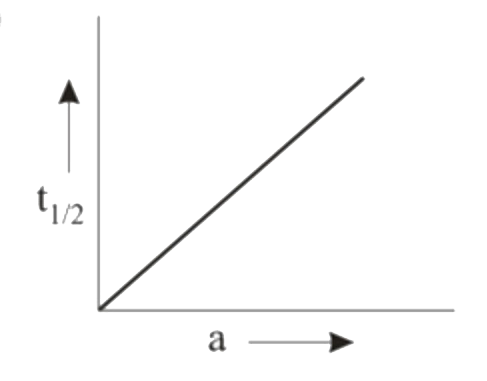Which of the following is correct representation of the variation of half - life with initial concentration of a zero order reaction ?




The correct Answer is:A
To solve the problem regarding the variation of half-life with initial concentration in a zero-order reaction, we can follow these steps:
1. Understand the Zero-Order Reaction Equation:
The rate law for a zero-order reaction can be expressed as:
(A)t=(A)0−kt
where:
- (A)t is the concentration at time t,
- (A)0 is the initial concentration,
- k is the rate constant,
- t is time.
2. Determine the Half-Life Expression:
The half-life (t1/2) for a zero-order reaction is the time required for the concentration of the reactant to decrease to half of its initial concentration. At half-life:
(A)t1/2=(A)02
3. Set Up the Equation for Half-Life:
Substitute (A)t1/2 into the zero-order reaction equation:
(A)02=(A)0−kt1/2
4. Rearrange the Equation:
Rearranging gives:
kt1/2=(A)0−(A)02
Simplifying this, we find:
kt1/2=(A)02
5. Solve for Half-Life:
Now, we can express the half-life in terms of the initial concentration:
t1/2=(A)02k
6. Analyze the Relationship:
From the equation t1/2=(A)02k, we can see that:
- t1/2 is directly proportional to the initial concentration (A)0 since 2k is a constant.
7. Graphical Representation:
Since t1/2 increases linearly with (A)0, the graph of half-life (t1/2) versus initial concentration ((A)0) will be a straight line.
Conclusion:
The correct representation of the variation of half-life with initial concentration of a zero-order reaction is a straight line graph, indicating that half-life is directly proportional to the initial concentration.
The rate law for a zero-order reaction can be expressed as:
(A)t=(A)0−kt
where:
- (A)t is the concentration at time t,
- (A)0 is the initial concentration,
- k is the rate constant,
- t is time.
The half-life (t1/2) for a zero-order reaction is the time required for the concentration of the reactant to decrease to half of its initial concentration. At half-life:
(A)t1/2=(A)02
Substitute (A)t1/2 into the zero-order reaction equation:
(A)02=(A)0−kt1/2
Rearranging gives:
kt1/2=(A)0−(A)02
Simplifying this, we find:
kt1/2=(A)02
Now, we can express the half-life in terms of the initial concentration:
t1/2=(A)02k
From the equation t1/2=(A)02k, we can see that:
- t1/2 is directly proportional to the initial concentration (A)0 since 2k is a constant.
Since t1/2 increases linearly with (A)0, the graph of half-life (t1/2) versus initial concentration ((A)0) will be a straight line.
The correct representation of the variation of half-life with initial concentration of a zero-order reaction is a straight line graph, indicating that half-life is directly proportional to the initial concentration.
Similar Questions
Knowledge Check
Half-life period of a zero order reaction is
Aproportional to initial concentration of reactantsBindependent of initial concentration of reactantsCinversely proportional to initial concentrations of reactantsDincersely proportional to the square of initial concentration of reactants
Which of the following graph is correct for zero order reaction?
View SolutionWhich of the following expression is correct for first order reaction? Ao refers to initial concentration of reactant
View SolutionWhich of the following is/are correct for the first order reaction ? (a is initial concentration of reactant, x is concentration of the reactant reacted and t is time)

View SolutionWhich of the following is correct for zero and first order reactions respectively, where 'a' is initial concentration of the reactant ?
View SolutionWhich of the following expresison is correct for first order reaction (c0 refers to initial concentration of reactant)
View SolutionHalf life period of 2 nd order reaction is
View SolutionWhich of the following expressions is correct for zero order respectively [Where a is initial concentration]?
View Solution
